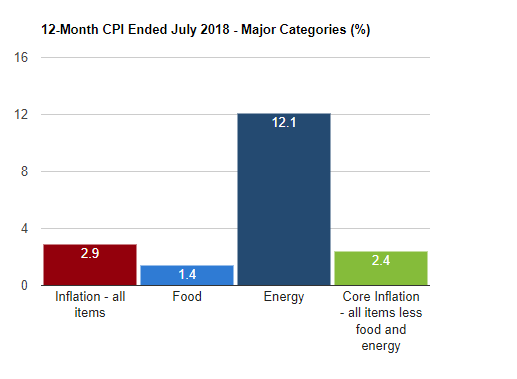SHARE
Current State Of A Buyer’s Mind-Set
Things are happening, and our strategy team would like to share two main cultural and socioeconomic events that are, or may soon be, affecting consumers’ buying habits.
I think it’s important to frame what a consumer may think and feel with what’s happening around them outside of the market transaction of goods. After all, there are many factors that contribute to how and when a consumer will spend. Outside of natural disasters, armed conflicts or goods shortages, there are a few things that happen with more regularity that can shift habits for all of us.
Rising Interest Rates
One such currently is the fact that the Federal Reserve recently signaled another possible rate increase in September. The year 2017 ended with an increase of 25 basis points as inflation hovered around 1.7%. The magic percentage, 2%, is what the Federal Reserve uses to judge an acceptable inflation rate for price stability and maximum employment. As we near it, this is an important indicator for several reasons beyond interest rate increases to mortgages, car loans and credit cards. For a marketer, it should mean that consumers will be looking to extend their cash a little further.

Additionally, we recently entered a 10-year high in core inflation. What this may mean is a more fiscally conservative general population moving into 2019. Spend will continue to occur, albeit cautiously, and marketers may need to increasingly focus on timelier offers that pair products with emotional triggers, as well as clearly differentiating their product from others on value. (See our previous posts on emotion and rational messaging.)
Trust
The other thing that’s happening is general distrust across all institutions in the U.S. According to Edelman, there was a 37-point aggregate drop in trust from 2017. A closer look reveals greater distrust across platforms (social, search) and an increase in trust among journalism. And this makes sense considering the privacy issues and legitimate news concerns we’ve experienced as of late. For marketers, it may mean that trust will be harder to develop over time if your business is focused on scaling and keeping customers long term. Questions marketers should consider are:
- How do I start this relationship right to elicit repeat buying, engagement and advocacy?
- How do I create a brand experience early on that provides customers with a sense of comfort, belonging and trust?
- What are my competitors doing to generate trust over time?
So, in a world where trust could be waning and prices across industries may be rising, how do you break through with marketing and get consumers to react? Offers aside, and assuming you have mechanisms in place for delivering timely and relevant messaging, you address trust by aligning your product with trust, and you address cost concerns by directly challenging perceptions about your competitors with value messaging and elements of emotion. Why would this be?
Mind-Sets
We return to the focal concern for marketers: of messaging consumers during moments at which we understand their concerns, their anxiety, their excitement. From Think with Google (July 2018):
Knowing when your audience is most receptive, moments when you can really capture someone’s attention or change their mind, and then meeting them with the right message…
This is truly the desired state for marketing, and in future posts we can share some concrete examples and ideas around the mechanisms required to operationally pull it off. I hope this is useful in planning for 2019. Our number-one suggestion is to take what’s happening in society and begin applying it to your marketing programs, starting with building a long-term, trust-oriented focus to acquire and keep customers. As always, it’s important to look at culture and other external factors when trying to evaluate a consumer’s mind-set. Otherwise, we’re evaluating only a small piece of the iceberg.
Current State Of A Buyer’s Mind-Set
SHARE
Things are happening, and our strategy team would like to share two main cultural and socioeconomic events that are, or may soon be, affecting consumers’ buying habits.
I think it’s important to frame what a consumer may think and feel with what’s happening around them outside of the market transaction of goods. After all, there are many factors that contribute to how and when a consumer will spend. Outside of natural disasters, armed conflicts or goods shortages, there are a few things that happen with more regularity that can shift habits for all of us.
Rising Interest Rates
One such currently is the fact that the Federal Reserve recently signaled another possible rate increase in September. The year 2017 ended with an increase of 25 basis points as inflation hovered around 1.7%. The magic percentage, 2%, is what the Federal Reserve uses to judge an acceptable inflation rate for price stability and maximum employment. As we near it, this is an important indicator for several reasons beyond interest rate increases to mortgages, car loans and credit cards. For a marketer, it should mean that consumers will be looking to extend their cash a little further.

Additionally, we recently entered a 10-year high in core inflation. What this may mean is a more fiscally conservative general population moving into 2019. Spend will continue to occur, albeit cautiously, and marketers may need to increasingly focus on timelier offers that pair products with emotional triggers, as well as clearly differentiating their product from others on value. (See our previous posts on emotion and rational messaging.)
Trust
The other thing that’s happening is general distrust across all institutions in the U.S. According to Edelman, there was a 37-point aggregate drop in trust from 2017. A closer look reveals greater distrust across platforms (social, search) and an increase in trust among journalism. And this makes sense considering the privacy issues and legitimate news concerns we’ve experienced as of late. For marketers, it may mean that trust will be harder to develop over time if your business is focused on scaling and keeping customers long term. Questions marketers should consider are:
- How do I start this relationship right to elicit repeat buying, engagement and advocacy?
- How do I create a brand experience early on that provides customers with a sense of comfort, belonging and trust?
- What are my competitors doing to generate trust over time?
So, in a world where trust could be waning and prices across industries may be rising, how do you break through with marketing and get consumers to react? Offers aside, and assuming you have mechanisms in place for delivering timely and relevant messaging, you address trust by aligning your product with trust, and you address cost concerns by directly challenging perceptions about your competitors with value messaging and elements of emotion. Why would this be?
Mind-Sets
We return to the focal concern for marketers: of messaging consumers during moments at which we understand their concerns, their anxiety, their excitement. From Think with Google (July 2018):
Knowing when your audience is most receptive, moments when you can really capture someone’s attention or change their mind, and then meeting them with the right message…
This is truly the desired state for marketing, and in future posts we can share some concrete examples and ideas around the mechanisms required to operationally pull it off. I hope this is useful in planning for 2019. Our number-one suggestion is to take what’s happening in society and begin applying it to your marketing programs, starting with building a long-term, trust-oriented focus to acquire and keep customers. As always, it’s important to look at culture and other external factors when trying to evaluate a consumer’s mind-set. Otherwise, we’re evaluating only a small piece of the iceberg.
Current State Of A Buyer’s Mind-Set
SHARE
Things are happening, and our strategy team would like to share two main cultural and socioeconomic events that are, or may soon be, affecting consumers’ buying habits.
I think it’s important to frame what a consumer may think and feel with what’s happening around them outside of the market transaction of goods. After all, there are many factors that contribute to how and when a consumer will spend. Outside of natural disasters, armed conflicts or goods shortages, there are a few things that happen with more regularity that can shift habits for all of us.
Rising Interest Rates
One such currently is the fact that the Federal Reserve recently signaled another possible rate increase in September. The year 2017 ended with an increase of 25 basis points as inflation hovered around 1.7%. The magic percentage, 2%, is what the Federal Reserve uses to judge an acceptable inflation rate for price stability and maximum employment. As we near it, this is an important indicator for several reasons beyond interest rate increases to mortgages, car loans and credit cards. For a marketer, it should mean that consumers will be looking to extend their cash a little further.

Additionally, we recently entered a 10-year high in core inflation. What this may mean is a more fiscally conservative general population moving into 2019. Spend will continue to occur, albeit cautiously, and marketers may need to increasingly focus on timelier offers that pair products with emotional triggers, as well as clearly differentiating their product from others on value. (See our previous posts on emotion and rational messaging.)
Trust
The other thing that’s happening is general distrust across all institutions in the U.S. According to Edelman, there was a 37-point aggregate drop in trust from 2017. A closer look reveals greater distrust across platforms (social, search) and an increase in trust among journalism. And this makes sense considering the privacy issues and legitimate news concerns we’ve experienced as of late. For marketers, it may mean that trust will be harder to develop over time if your business is focused on scaling and keeping customers long term. Questions marketers should consider are:
- How do I start this relationship right to elicit repeat buying, engagement and advocacy?
- How do I create a brand experience early on that provides customers with a sense of comfort, belonging and trust?
- What are my competitors doing to generate trust over time?
So, in a world where trust could be waning and prices across industries may be rising, how do you break through with marketing and get consumers to react? Offers aside, and assuming you have mechanisms in place for delivering timely and relevant messaging, you address trust by aligning your product with trust, and you address cost concerns by directly challenging perceptions about your competitors with value messaging and elements of emotion. Why would this be?
Mind-Sets
We return to the focal concern for marketers: of messaging consumers during moments at which we understand their concerns, their anxiety, their excitement. From Think with Google (July 2018):
Knowing when your audience is most receptive, moments when you can really capture someone’s attention or change their mind, and then meeting them with the right message…
This is truly the desired state for marketing, and in future posts we can share some concrete examples and ideas around the mechanisms required to operationally pull it off. I hope this is useful in planning for 2019. Our number-one suggestion is to take what’s happening in society and begin applying it to your marketing programs, starting with building a long-term, trust-oriented focus to acquire and keep customers. As always, it’s important to look at culture and other external factors when trying to evaluate a consumer’s mind-set. Otherwise, we’re evaluating only a small piece of the iceberg.
